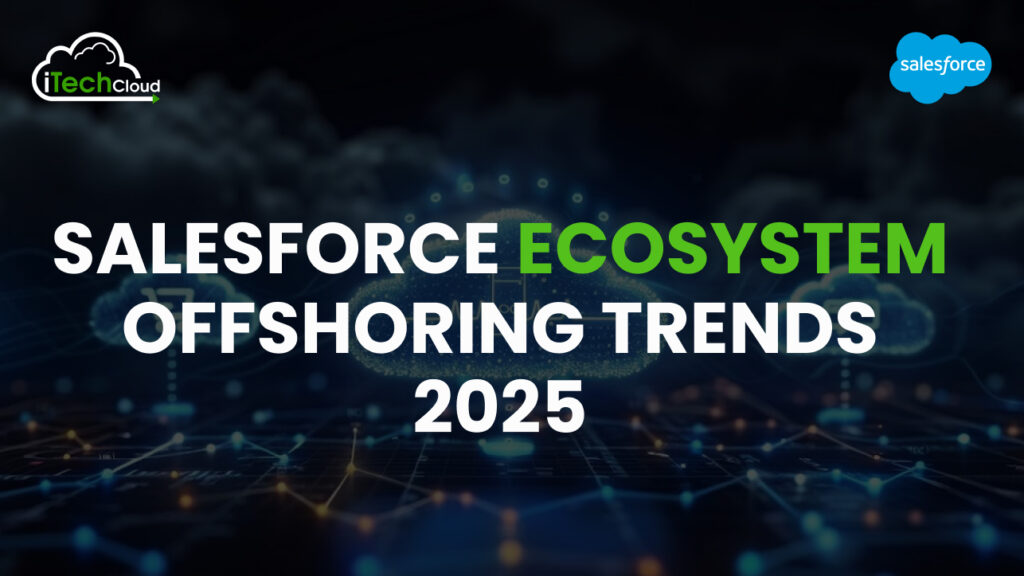Salesforce Ecosystem Offshoring Trends 2025

The Salesforce ecosystem continues to expand, creating more demand for skilled professionals, innovative solutions, and seamless customer experiences. Offshoring has become a key strategy for companies leveraging Salesforce to maximize operational efficiency, minimize costs, and accelerate project timelines. In 2025, offshoring in the Salesforce ecosystem is poised to grow at an unprecedented pace, driven by several emerging trends, technological advancements, and global economic shifts.
This blog explores the major offshoring trends that will shape the Salesforce ecosystem in 2025 and how businesses can capitalize on these trends to stay ahead in an ever-evolving market.
Table of Contents
📈 1. Increasing Demand for Specialized Salesforce Expertise
As Salesforce continues to expand its portfolio with advanced products like MuleSoft, Tableau, Slack, Einstein AI, and Commerce Cloud, the demand for specialized expertise in these areas has surged. Many companies lack the in-house expertise required to manage these complex platforms effectively, driving the need to offshore specialized tasks to experienced partners.
Key Trends:
- Growth of Specialized Offshore Centers: Offshore centers in India, the Philippines, and Eastern Europe are ramping up their focus on advanced Salesforce products to meet growing demands.
- AI and Automation Integration: Offshore partners are training their teams to work with Einstein AI, enabling businesses to automate processes and provide smarter customer experiences.
- Increased Demand for Industry-Specific Solutions: Industries such as healthcare, finance, and retail are seeking tailored Salesforce solutions, further fueling the need for offshore specialists with domain expertise.
🧠 2. Expansion of AI and Automation in Offshoring
AI and automation technologies are revolutionizing the way offshoring is approached within the Salesforce ecosystem. As businesses aim to streamline repetitive tasks and reduce operational costs, they are increasingly leveraging AI-powered tools and robotic process automation (RPA) to automate routine Salesforce operations.
Key Trends:
- AI-Driven Development and Testing: AI tools are being used to accelerate the development lifecycle of Salesforce applications and ensure higher code quality.
- Intelligent Automation for Data Migration: Automated data migration tools with AI capabilities are reducing errors and improving data integrity during Salesforce migrations.
- AI-Powered Support and Chatbots: Offshore teams are integrating AI-based chatbots and virtual assistants into Salesforce Service Cloud to enhance customer support and reduce workload.
🌐 3. Growing Popularity of Nearshoring and Hybrid Models
Nearshoring (outsourcing to geographically closer countries) is gaining traction. Businesses are adopting hybrid models that combine offshore, nearshore, and onshore talent to strike a balance between cost efficiency and quality.
Key Trends:
- Hybrid Team Structures: Companies are maintaining core teams onshore while delegating specialized tasks to offshore and nearshore teams for optimal efficiency.
- Nearshore Talent Pools in Latin America and Eastern Europe: Countries like Mexico, Brazil, Poland, and Ukraine are becoming preferred nearshore destinations for US and European companies.
- Faster Turnaround with Time Zone Proximity: Nearshoring provides better time zone alignment, enabling real-time collaboration and faster project completion.
💻 4. Rise of Salesforce DevOps and Agile Delivery Models
The adoption of DevOps and Agile methodologies in Salesforce development is becoming a standard practice. Offshoring partners are embracing these models to ensure continuous integration, faster deployments, and improved collaboration between development and operations teams.
Key Trends:
- Increased Adoption of CI/CD Pipelines: Offshore teams are implementing Continuous Integration and Continuous Delivery (CI/CD) pipelines to automate the deployment of Salesforce applications.
- Agile Offshore Teams for Faster Delivery: Agile methodologies are being adopted by offshore teams to deliver iterative releases, ensuring faster time-to-market and enhanced customer satisfaction.
- Enhanced Collaboration Through DevOps Tools: Tools like GitHub, Bitbucket, Jenkins, and Copado are being used to enable seamless collaboration between onshore and offshore teams.
🔐 5. Stronger Focus on Security and Compliance
With increasing concerns about data privacy and cybersecurity, companies are placing a greater emphasis on ensuring that offshore Salesforce development and support teams adhere to global security standards and regulatory compliance.
Key Trends:
- Implementation of Zero-Trust Security Models: Offshore teams are implementing zero-trust frameworks to ensure secure access to Salesforce environments.
- Compliance with GDPR, CCPA, and Other Regulations: Offshore partners are investing in training and compliance frameworks to ensure adherence to global data protection laws.
- Regular Security Audits and Penetration Testing: Offshore teams are conducting regular security audits and penetration testing to identify vulnerabilities and mitigate risks.
📊 6. Demand for Salesforce Managed Services and Support
As organizations continue to scale their Salesforce operations, the need for ongoing managed services and support has grown significantly. Businesses are increasingly outsourcing Salesforce managed services to offshore providers who offer 24/7 support, system maintenance, and performance optimization.
Key Trends:
- Round-the-Clock Salesforce Support: Offshore teams are providing 24/7 Salesforce administration and technical support to ensure minimal downtime.
- Proactive System Monitoring and Optimization: Offshore providers are leveraging AI and analytics to proactively identify and resolve system performance issues.
- Scalable Managed Service Models: Offshore partners are offering flexible and scalable managed service models to accommodate the evolving needs of businesses.
🧩 7. Low-Code and No-Code Development Adoption
The rise of low-code and no-code platforms in the Salesforce ecosystem is empowering business users to build applications without extensive coding knowledge. Offshore teams are leveraging these platforms to accelerate application development and reduce dependency on traditional development cycles.
Key Trends:
- Rapid Application Development with Salesforce Lightning Platform: Offshore developers are using Salesforce Lightning and AppExchange solutions to rapidly build and deploy applications.
- Low-Code Customization for Faster Deployments: Offshore partners are implementing low-code solutions to customize Salesforce instances without extensive development efforts.
- Citizen Development Support: Offshore teams are providing guidance and support to business users adopting no-code platforms, empowering them to create business applications independently.
🤝 8. Focus on Customer Experience (CX) and Personalization
In 2025, delivering exceptional customer experiences (CX) through personalized interactions will be a top priority for businesses. Offshore partners are helping organizations leverage Salesforce’s capabilities to enhance customer journeys and deliver highly personalized services.
Key Trends:
- Hyper-Personalization Using AI and Analytics: Offshore teams are using AI to analyze customer data and deliver personalized recommendations and interactions.
- Omni-Channel Customer Engagement: Offshore partners are integrating multiple communication channels within Salesforce Service Cloud to ensure seamless customer engagement.
- Customer Journey Mapping for Enhanced CX: Offshore consultants are assisting companies in mapping customer journeys and optimizing touchpoints to improve overall customer satisfaction.
🚀 9. Growing Demand for Multi-Cloud Expertise
As organizations adopt multi-cloud strategies to enhance flexibility and resilience, the demand for offshore partners with expertise in Salesforce, AWS, Azure, and Google Cloud is surging. Businesses are looking for partners who can integrate Salesforce with other cloud platforms to create seamless, scalable, and secure ecosystems.
Key Trends:
- Multi-Cloud Orchestration and Integration: Offshore teams are building expertise in integrating Salesforce with AWS, Azure, and Google Cloud to enable unified workflows.
- Hybrid Cloud Deployment Models: Offshore providers are offering hybrid cloud solutions to help businesses achieve data sovereignty and regulatory compliance.
- Cross-Cloud Security Implementation: Offshore security teams are ensuring data protection across multiple cloud environments through encryption, access control, and threat monitoring.
📚 10. Investment in Upskilling and Certification
Offshore teams are investing heavily in Salesforce certifications and upskilling programs to stay ahead of the curve. With Salesforce continuously evolving, offshore partners recognize the importance of ensuring their teams are well-versed in the latest technologies and best practices.
Key Trends:
- Increased Focus on Salesforce Certifications: Offshore companies are encouraging their employees to obtain Salesforce Administrator, Developer, and Consultant certifications.
- Continuous Learning Through Trailhead and Training Programs: Offshore teams are leveraging Salesforce’s Trailhead platform to stay updated on new releases and functionalities.
- Partnerships with Salesforce for Advanced Training: Offshore service providers are partnering with Salesforce to provide advanced training and mentorship to their teams.
📢 Conclusion: Salesforce Ecosystem Offshoring Trends
The Salesforce ecosystem is evolving rapidly, and offshoring is playing a pivotal role in helping organizations drive innovation, enhance customer experiences, and optimize costs. By staying ahead of these emerging trends, businesses can leverage offshore expertise to unlock the full potential of Salesforce and gain a competitive advantage in 2025.

